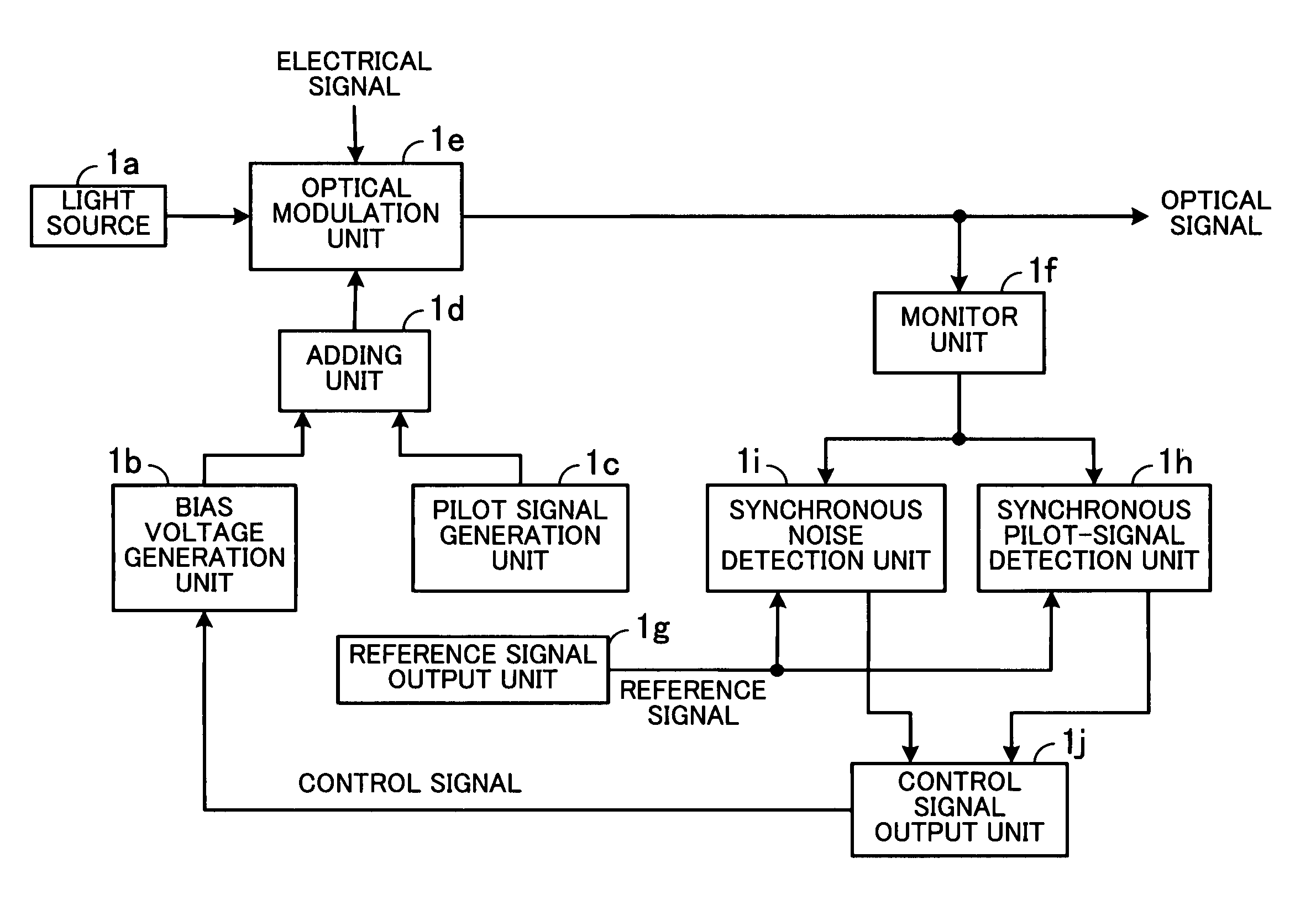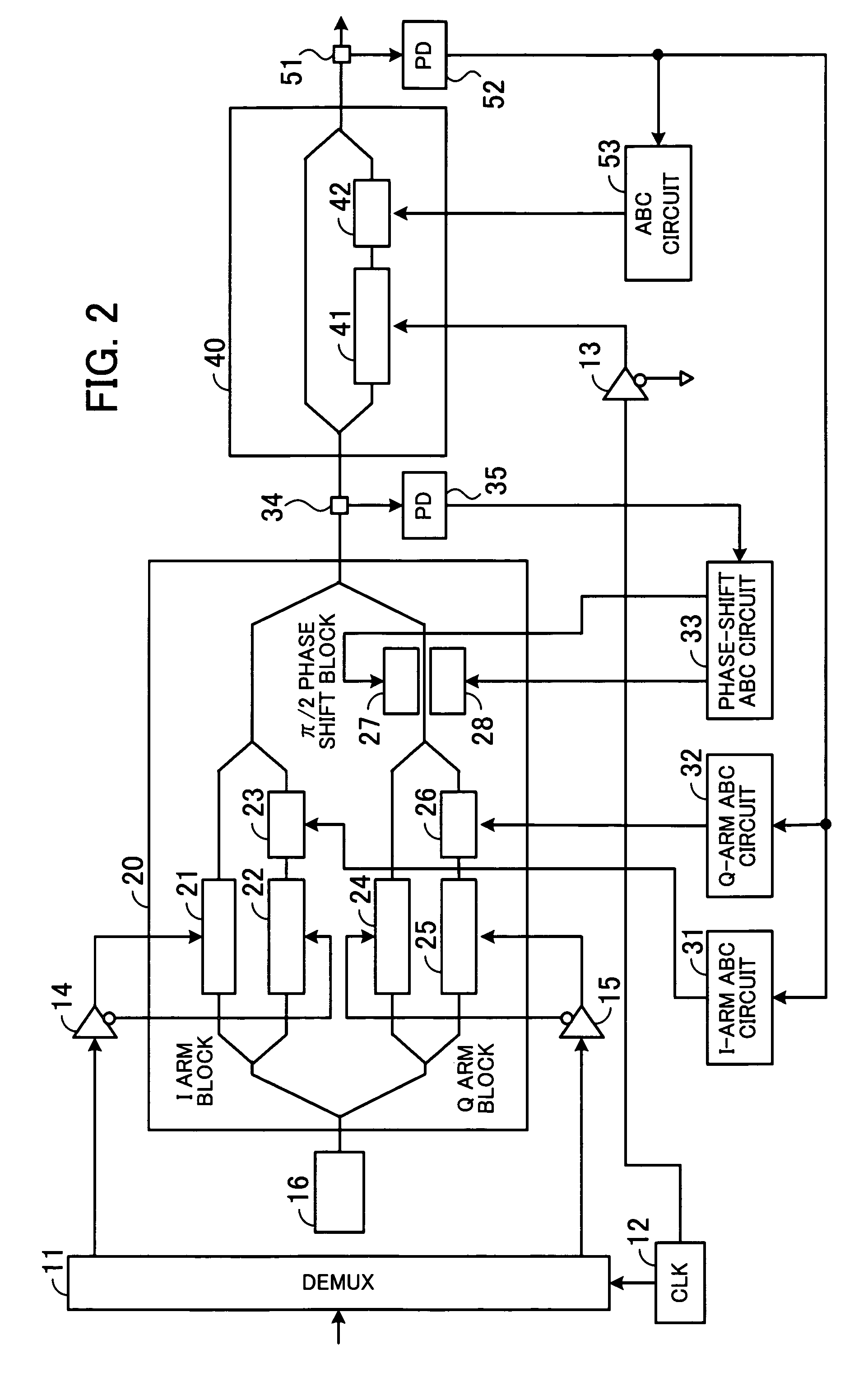Optical communication apparatus
a communication apparatus and optical technology, applied in the field of optical communication apparatuses, can solve the problems of difficult control of the operating point of the optical modulator appropriately, drift generation, interference-type optical modulation element operation point, etc., and achieve the effect of removing noise from a synchronous detection signal
- Summary
- Abstract
- Description
- Claims
- Application Information
AI Technical Summary
Benefits of technology
Problems solved by technology
Method used
Image
Examples
first embodiment
[0055]the present invention will be described below in detail with reference to the drawings.
[0056]FIG. 2 is a block diagram showing the configuration of an optical communication apparatus of the first embodiment. The shown optical communication apparatus corresponds to the O / E 101a, the light source 102a, and the optical modulator 103a of the WDM transmission block, described with reference to FIG. 12. The shown optical communication apparatus performs optical modulation of an electrical signal and outputs the signal to the optical multiplexer 104.
[0057]A DEMUX 11 receives an electrical signal transmitted to the WDM reception block. The electrical signal input to the DEMUX 11 is a 43-Gb / s signal, for instance. The DEMUX 11 also receives a 21.5-GHz clock from a CLK 12, divides the input electrical signal into two 21.5-Gb / s signals, and outputs the signals to amplifiers 14 and 15, for instance.
[0058]The amplifier 14 amplifies an electrical signal output from one end of the DEMUX 11 a...
second embodiment
[0097]FIG. 8 is a block diagram showing the configuration of an optical communication apparatus of the In FIG. 8, circuits identical to those shown in FIG. 7 are denoted by the same reference numerals, and a description thereof is omitted.
[0098]A phase shifter 91 adjusts the phase of the pilot signal output from the pilot signal generator 64 so that the signal becomes in phase with the pilot signal output from the ADC 72, and outputs the signal to a multiplier 73 as a reference signal. The phase shifter 91 also outputs a reference signal 90° out of phase from the reference signal output to the multiplier 73 to a multiplier 92.
[0099]Suppose that the phase shifter 91 outputs a reference signal “a” degrees out of phase from the pilot signal to the multiplier 73. The phase shifter 91 outputs a reference signal (a+90) degrees out of phase from the pilot signal to the multiplier 92. Alternatively, the phase shifter 91 outputs a reference signal (a−90) degrees (=(a+270) degrees) out of ph...
third embodiment
[0108]FIG. 10 is a block diagram showing the configuration of an optical communication apparatus of the In FIG. 10, circuits identical to those shown in FIG. 7 are denoted by the same reference numerals, and a description thereof will be omitted.
[0109]In FIG. 10, the BPF 70 included in FIG. 7 is omitted. The output of the demodulator 69 is given to the AMP 71 and BEF 81.
[0110]The multiplier 73 and LPF 75 perform synchronous detection of the pilot signal and also function as a BPF. When a great influence of noise is found in the synchronous detection of the pilot signal, the BPF 70 can be disposed after the demodulator 69, as shown in FIG. 7, in order to remove signals having frequencies other than 1 kHz.
[0111]The BPF 70 can be omitted if the influence of noise is small. Accordingly, the number of components can be reduced.
[0112]If a direct-current voltage is applied to the output of the demodulator 69, a circuit for removing the direct-current component is disposed after the demodu...
PUM
| Property | Measurement | Unit |
|---|---|---|
| center frequency | aaaaa | aaaaa |
| bias voltage | aaaaa | aaaaa |
| frequency | aaaaa | aaaaa |
Abstract
Description
Claims
Application Information
 Login to View More
Login to View More - R&D
- Intellectual Property
- Life Sciences
- Materials
- Tech Scout
- Unparalleled Data Quality
- Higher Quality Content
- 60% Fewer Hallucinations
Browse by: Latest US Patents, China's latest patents, Technical Efficacy Thesaurus, Application Domain, Technology Topic, Popular Technical Reports.
© 2025 PatSnap. All rights reserved.Legal|Privacy policy|Modern Slavery Act Transparency Statement|Sitemap|About US| Contact US: help@patsnap.com



